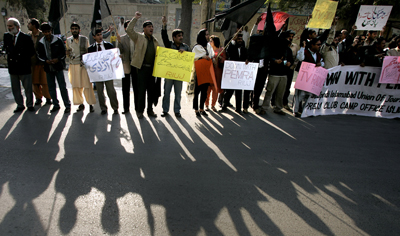November 3, 2007, was a dark day in the history of Pakistan’s media. Former military dictator General Pervez Musharraf banned all private news channels, and some entertainment and sports channels, through an “oral order.” He said he made the move to stop “irresponsible journalism.” Many of the staff in the president’s office who dealt with the media were unaware of his decision; intelligence agencies were used to tell the cable operators to pull the channels off air. Media reacted strongly. After 80 days of struggle, jailings, and legal battles, including sedition cases brought against some journalists, the government backed down from its decision and allowed the channels back on air.
The media were the targets of what came to be called Musharraf’s “Emergency Plus.” After some of the channels started to broadcast by satellite from Dubai, Musharraf pressured the government there to shut down the channels’ operations. That plan eventually failed after international pressure. Musharraf then tried to stop the sale of satellite dishes for home use in Pakistan.
Journalists and the Pakistan Federal Union of Journalists (PFUJ) leadership were threatened with dire consequences. I still remember the telephone call from an intelligence official on the night of November 3, telling me not to organize journalists for street demonstrations. “There is a zero tolerance policy for you and the PFUJ’s leadership,” I was told.
The PFUJ called an emergency meeting of its Federal Executive Council on November 5. When a large number of FEC members and journalists from the Rawalpindi-Islamabad Union of Journalists turned up, we decided to launch our countermovement on November 7 with a rally and a march to the prime minister’s house. We had a huge turnout, which established the momentum we needed for the long movement. The next day, 200 cases were filed against demonstrating journalists for “attacking the prime minister’s house.”
International support from International Federation of Journalists, the Committee to Protect Journalists, Reporters Without Borders, and other organizations were a source of inspiration we needed. During those 80 days, sedition cases were registered against the PFUJ during a prolonged protest at a journalist encampment outside the Dawn newspaper offices in Islamabad. In Karachi, some 200 journalists were hauled in by police during a rally.
Under increasing pressure, the government’s next step was to tack on an amendment to the Pakistan Electronic Media Reform Act that barred media from criticizing the president. Owners of some of the channels also signed on to a controversial government-written “code of conduct,” despite resistance from the PFUJ.
In the end, faced with the prolonged militancy of journalists, Musharraf had to back down from the confrontation. Cable carriers were allowed to broadcast the channels, and the clear message was given to the future administrations that journalists will battle to maintain media freedom in Pakistan.
For journalists, November 2007 was the biggest test of freedom of the press since the 1978 historic movement against the ban on newspapers, the highly restrictive 1966 Press and Publication Ordinance, or the 1970 journalists wage strike. No government would now dare to impose a ban, having learned the lessons from journalists’ actions in 2007.
For more background on Abbas’ recollections, see our 2007 Attacks on the Press year-end essay–“Amid South Asian Conflict, Remarkable Resilience“– that discusses the challenges faced by Pakistani and other South Asian journalists. And for a fuller account of the events in Pakistan in 2007, here is CPJ’s annual summary of events in Pakistan in 2007.
